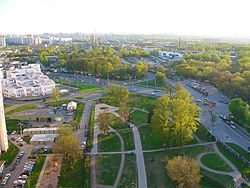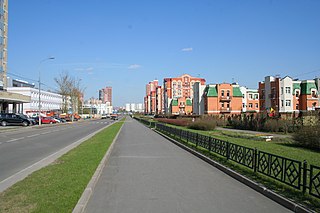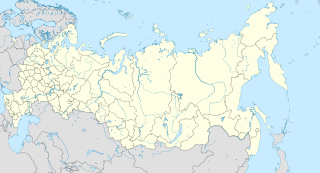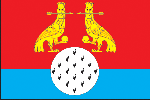Lyublino District | |||
|---|---|---|---|
 Verhnie Polia Street, Lyublino District | |||
| |||
| Location of Lyublino District in the City of Moscow | |||
| Coordinates: 55°40′30″N37°46′00″E / 55.67500°N 37.76667°E Coordinates: 55°40′30″N37°46′00″E / 55.67500°N 37.76667°E | |||
| Country | Russia | ||
| Federal subject | Moscow | ||
| Population | |||
| • Estimate (2018) [1] | 171,946 | ||
| Time zone | UTC+3 (MSK | ||
| OKTMO ID | 45389000 | ||
| Website | http://lublino.mos.ru/ | ||

Lyublino (Russian : Люблино) is a district of South-Eastern Administrative Okrug of the federal city of Moscow, Russia. Population: 165,759 (2010 Census); [3] 152,100 (2002 Census). [4] The district's area is 17.41 square kilometers (6.72 sq mi), making it the ninth biggest district in Moscow.[ citation needed ]

Russian is an East Slavic language, which is official in the Russian Federation, Belarus, Kazakhstan and Kyrgyzstan, as well as being widely used throughout Eastern Europe, the Baltic states, the Caucasus and Central Asia. It was the de facto language of the Soviet Union until its dissolution on 25 December 1991. Although nearly three decades have passed since the breakup of the Soviet Union, Russian is used in official capacity or in public life in all the post-Soviet nation-states, as well as in Israel and Mongolia.

The federal city of Moscow, Russia is divided into twelve administrative okrugs, which are in turn subdivided into districts (raions). The city does not have a downtown area; the urban core is scattered across the city. Prominent business areas include Tverskoy, Arbat, and Presnensky Districts. Central Administrative Okrug as a whole has a large concentration of businesses. The city hall and major administration buildings are located in Tverskoy District. Western Administrative Okrug is home to Moscow State University, Sparrow Hills and Mosfilm Studios, while North-Eastern hosts Ostankino Tower and VDNKh Exhibition Park. The total population of the Federal City of Moscow was 11,503,501 inhabitants at the Russian Census (2010).
South-Eastern Administrative Okrug, or Yugo-Vostochny Administrative Okrug, is one of the twelve high-level territorial divisions of the federal city of Moscow, Russia. As of the 2010 Census, its population was 1,318,885, up from 1,109,121 recorded during the 2002 Census.
Contents























